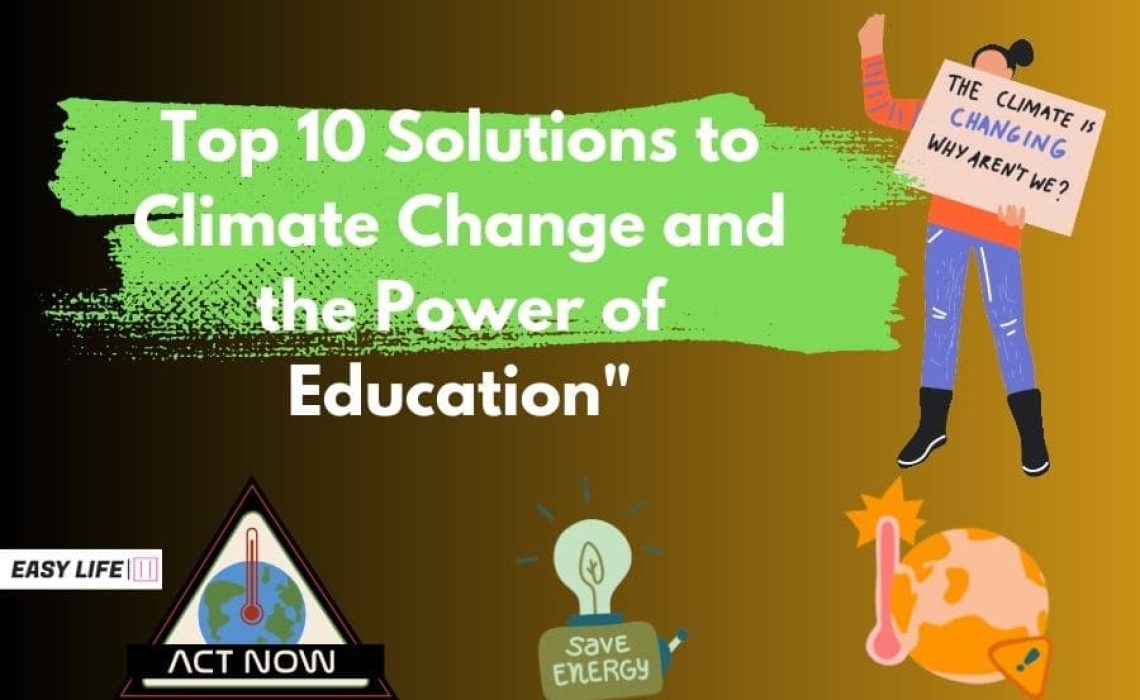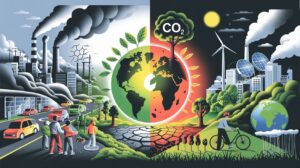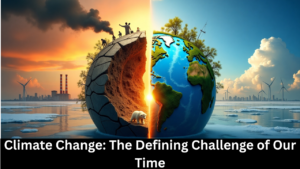Climate change, often referred to as global warming, is a complex and pressing issue that poses severe threats to our planet. Its impacts range from the melting of polar ice caps and rising sea levels to increased frequency and intensity of extreme weather events. These changes, driven largely by human activities, have widespread implications for ecosystems, economies, and human health. Here we discussed the Top 10 Solutions to Climate Change.
The urgency to find effective solutions to combat climate change has never been greater. Scientists, policymakers, and individuals worldwide are increasingly seeking strategies to mitigate the adverse effects of climate change and to build a more sustainable future.
Table of Contents
Toggle1. Understanding Climate Change Solutions
To help frame our understanding and response to this global crisis, this blog post will discuss the top 10 solutions to climate change, drawing on insights from a variety of sources, including the highly respected Drawdown.org. These solutions emphasize the importance of diverse strategies, from renewable energy and energy efficiency to education and family planning.
Through this exploration, we aim to demonstrate that while the challenges are indeed significant, there are many ways in which we can act to combat climate change. The journey towards a more sustainable future requires collective action and shared responsibility, and we hope this blog post will inspire you to play your part.
2. Top 10 Solutions to Climate Change
A. Renewable Energy
Renewable energy refers to power generated from natural resources that are continuously replenished. These include solar, wind, hydro, and geothermal power. The shift from fossil fuels to renewable energy sources is a crucial part of combating climate change as it significantly reduces greenhouse gas emissions. With advancements in technology, renewable energy is becoming more affordable and accessible, making it a viable solution for a sustainable future.
B. Energy Efficiency
Improving energy efficiency means doing more with less energy. This involves technologies and practices that reduce energy consumption and emissions in various sectors like buildings, transportation, and industry. From energy-efficient appliances to better-insulated homes, to improved industrial processes, these solutions help conserve energy and decrease carbon emissions.
C. Sustainable Agriculture
Sustainable agriculture practices promote farming methods that are environmentally friendly, economically viable, and socially just. These practices include organic farming, agroforestry, and regenerative agriculture. By reducing reliance on chemical fertilizers and pesticides, and by improving soil health, sustainable agriculture can significantly reduce greenhouse gas emissions.
D. Forest Restoration
Forests act as carbon sinks, absorbing CO2 from the atmosphere. Forest restoration, which includes reforestation and preventing deforestation, can help increase carbon sequestration, thus playing a vital role in climate change mitigation. Additionally, forests provide habitat for wildlife, preserve biodiversity, and offer livelihoods for many communities.
E. Plant-rich Diet
Adopting a plant-rich diet involves reducing the consumption of meat and dairy products and increasing the intake of plant-based foods. Livestock farming is a significant contributor to greenhouse gas emissions. Thus, shifting dietary habits can have a substantial impact on reducing our carbon footprint.
F. Reduced Food Waste
Approximately a third of all food produced globally goes to waste, contributing to 8% of total global greenhouse gas emissions. Reducing food waste can significantly lower these emissions. This can be achieved through improved food storage, distribution, consumption habits, and recycling of organic waste.
G. Education and Family Planning
Action on climate change relies heavily on education and family planning.. Education equips people with knowledge about climate change and ways to mitigate it. Moreover, it empowers women, leading to lower birth rates, which can help manage population growth. Family planning ensures access to reproductive health services, enabling families to have the desired number of children, which can indirectly help reduce global carbon emissions.
H. Electrification of Transportation
Transportation accounts for a substantial part of global CO2 emissions. Transitioning to electric vehicles and other sustainable modes of transport powered by renewable energy can help reduce these emissions. Along with the adoption of public transit, biking, and walking, the electrification of transport is a crucial step towards a sustainable future.
I. Carbon Capture and Storage
Carbon capture and storage (CCS) involves capturing CO2 emissions from power plants and industrial processes, transporting it, and storing it underground. While this technology is still developing, it has the potential to significantly reduce CO2 emissions, making it an important part of the climate change solution.
J. Green Building Design
Green building design or sustainable architecture involves designing and constructing buildings in a way that reduces their environmental impact. This can be achieved through energy-efficient design, the use of sustainable materials, and the integration of renewable energy technologies. Green buildings reduce energy consumption and greenhouse gas emissions, contributing significantly to climate change mitigation.
3. Drawdown.org’s Role in Climate Change Solutions
Drawdown.org is a leading resource for identifying and promoting effective climate solutions. It is a non-profit organization committed to providing research-backed, scientifically credible solutions to address the pressing issue of global warming.
Drawdown.org has done extensive research to rank the most effective climate change solutions. Its work extends beyond simply listing these solutions; it provides detailed insights into the implementation, costs, and potential carbon savings of each solution. The organization focuses on a comprehensive approach to reversing global warming, looking at a range of areas from energy, food, and transport to buildings, cities, and health.
The top 10 solutions we’ve discussed in this blog align closely with the strategies proposed by Drawdown.org. Renewable energy, sustainable agriculture, education, and family planning are among the solutions highlighted by Drawdown.org, which validate the importance and potential impact of these strategies. Drawdown.org’s research also sheds light on other impactful solutions that deserve our attention.
By offering a platform where these solutions are clearly outlined and ranked based on their potential impact, Drawdown.org plays a vital role in guiding global efforts to mitigate climate change. It’s a valuable resource for policymakers, researchers, businesses, and individuals seeking to understand and contribute to climate change solutions.
4. Impact of Renewable Energy on Climate Change
Renewable energy sources, including solar, wind, hydroelectric, and geothermal, are central to addressing the issue of climate change. These energy sources offer a cleaner, more sustainable alternative to fossil fuels, which are the primary drivers of global warming due to their high carbon emissions when burned.
The impact of renewable energy on climate change can be seen through several key aspects:
1. Reduction in Greenhouse Gas Emissions:
The most significant benefit of renewable energy is its role in reducing greenhouse gas emissions. Unlike burning fossil fuels, which release a substantial amount of carbon dioxide and other harmful gases into the atmosphere, renewable energy technologies produce little to no greenhouse gas emissions during operation. This reduction in emissions is crucial for slowing the rate of global warming.
2. Decreased Air and Water Pollution:
Renewable energy technologies do not just lower carbon emissions but also have a smaller impact on air and water quality. Fossil fuel extraction, processing, and burning produce a variety of pollutants, including sulfur dioxide, nitrogen oxides, and particulate matter, which contribute to health issues and environmental degradation. In contrast, renewable energy technologies result in significantly less pollution, leading to cleaner air and water.
3. Mitigation of Energy-Related Water Use:
Traditional power generation methods, particularly nuclear and coal, require significant amounts of water for cooling. With growing water scarcity issues worldwide, shifting to renewable energy sources, especially wind and solar PV systems, can mitigate this water usage, as these technologies use significantly less water.
4. Energy Security and Resilience: Renewable energy technologies can be deployed almost anywhere, which diversifies the energy supply and reduces dependence on imported fuels. This increased energy security can help nations better withstand potential disruptions to the energy supply. In addition, distributed renewable energy systems can enhance the resilience of the electric grid against extreme weather events that are becoming more common due to climate change.
By continuing to invest in and develop renewable energy technologies, we can reduce our dependence on fossil fuels, decrease greenhouse gas emissions, and mitigate the impacts of climate change. It’s a clear path forward for ensuring a sustainable and resilient energy future.
5. Role of Education and Family Planning in Climate Action
Education and family planning play significant, though sometimes overlooked, roles in climate action. Both can contribute to lowering greenhouse gas emissions and building more resilient societies. Here’s how:
Education
- Increasing Awareness and Understanding: Education helps people understand the causes and effects of climate change, and the urgency to act. This awareness is fundamental for driving behaviour change and fostering a culture of sustainability.
- Promoting Sustainable Practices: Through education, individuals can learn about sustainable practices such as recycling, conservation, energy efficiency, and plant-based diets. Schools, colleges, and universities can incorporate sustainability into their curriculum, empowering students to make environmentally-friendly choices.
- Spurring Innovation: Education is also key to developing the next generation of innovators and problem-solvers who will create new technologies and solutions to address climate change.
- Empowering Women: Education, particularly for girls and women, has shown to be a powerful tool for family planning, reducing birth rates, and hence, slowing population growth. This can indirectly help reduce global carbon emissions.
Family Planning
- Population Control: Family planning services, including access to contraception and reproductive health education, enable people to choose the number and spacing of their children. By managing population growth, especially in high-consuming societies, we can limit the increase in greenhouse gas emissions.
- Empowering Women: Women with access to family planning resources tend to have fewer and healthier children, are more likely to participate in the workforce, and have more opportunities for education. Women’s empowerment is linked to many positive outcomes for society, including economic growth and reduced emissions.
- Health and Climate Co-benefits: Family planning can also lead to improved health outcomes, which have climate co-benefits. For example, fewer pregnancies reduce the demand for healthcare services, which in turn reduces energy consumption and related emissions in the healthcare sector.
- Building Resilient Societies: By reducing population pressure on resources, family planning can help build more resilient societies that are better equipped to cope with the impacts of climate change.
In summary, education and family planning are essential tools for empowering individuals and communities to take meaningful climate action. They help in creating a society that values sustainability, innovation, and equality.
6. Conclusion
Addressing the monumental challenge of climate change demands concerted global action across various sectors. The top 10 solutions we’ve discussed – renewable energy, energy efficiency, sustainable agriculture, forest restoration, plant-rich diets, reduced food waste, education, family planning, electrification of transportation, carbon capture and storage, and green building design – are essential components of a comprehensive response to this pressing issue.
These strategies not only help cut down on greenhouse gas emissions, but they also have a lot of other benefits, such as better air and water quality, better public health, and more economic chances. But for them to work, governments, businesses, and people all need to work together and make a commitment.
Organizations like Drawdown.org play a crucial role in identifying, studying, and promoting these solutions, guiding our collective efforts towards a more sustainable and resilient future.
The journey towards mitigating climate change is a long and challenging one. However, the urgency to act is clear, and the solutions are at our disposal. As we move forward, it is imperative that we embrace these solutions and strive to make sustainability an integral part of our lifestyles, economies, and societies.
In closing, we hope that this exploration has not only informed you but also inspired you to take part in climate action in whatever ways you can. Each of us has a role to play, and together, we can make a significant difference in the fight against climate change.
7. References
- Drawdown. (2020). The Drawdown Review. [Online] Available at: https://www.drawdown.org/drawdown-review
- Intergovernmental Panel on Climate Change (IPCC). (2021). Climate Change 2021: The Physical Science Basis. [Online] Available at: https://www.ipcc.ch/report/ar6/wg1/
- International Renewable Energy Agency (IRENA). (2020). Renewable Energy and Jobs – Annual Review 2020. [Online] Available at: https://www.irena.org/publications/2020/Sep/Renewable-Energy-and-Jobs-Annual-Review-2020
- Food and Agriculture Organization of the United Nations (FAO). (2019). The State of the World’s Biodiversity for Food and Agriculture. [Online] Available at: http://www.fao.org/3/CA3129EN/CA3129EN.pdf
- World Health Organization (WHO). (2018). Health benefits far outweigh the costs of meeting climate change goals. [Online] Available at: https://www.who.int/news-room/detail/05-12-2018-health-benefits-far-outweigh-the-costs-of-meeting-climate-change-goals
- United Nations Educational, Scientific and Cultural Organization (UNESCO). (2017). Education for Sustainable Development Goals: Learning Objectives. [Online] Available at: https://unesdoc.unesco.org/ark:/48223/pf0000247444
- United Nations Population Fund (UNFPA). (2023). State of World Population 2023. [Online] Available at: https://www.unfpa.org/swop
- U.S. Department of Energy. (2021). Benefits of Renewable Energy Use. [Online] Available at: https://www.eia.gov/energyexplained/renewable-sources/
It’s always good to check for more recent information or research as the science and understanding of climate change and its solutions continue to evolve.
8. Frequently Asked Questions about Climate Change
Q1: What is the role of renewable energy in combating climate change?
A1: Renewable energy sources such as solar, wind, and hydroelectric power play a critical role in combating climate change by replacing fossil fuels as our primary source of energy. This transition helps reduce greenhouse gas emissions, promotes energy independence, and supports long-term economic growth.
Q2: How does energy efficiency help in addressing climate change?
A2: Energy efficiency helps address climate change by reducing overall energy consumption and carbon emissions. By improving the efficiency of buildings, transportation, and appliances, we can conserve energy and minimize the environmental impact of our daily activities.
Q3: What is the difference between reforestation and afforestation?
A3: Planting trees in regions where forests have been cut or destroyed is referred to as reforestation, but planting trees in areas that have not been forested for a long time or have never had forests is referred to as afforestation. Both practices help combat climate change by increasing the number of trees that can absorb CO2 from the atmosphere.
Q4: Can carbon capture and storage technology effectively reduce greenhouse gas emissions?
A4: With carbon capture and storage (CCS) technology, greenhouse gas emissions from power companies and industrial sources could be cut by a lot. By capturing and storing CO2 emissions deep underground, CCS can help prevent large amounts of CO2 from entering the atmosphere, mitigating climate change.
Q5: How does sustainable agriculture contribute to climate change mitigation?
A5: Sustainable agriculture contributes to climate change mitigation by reducing the environmental impact of food production. This includes promoting organic farming, reducing food waste, and encouraging plant-based diets, which help decrease greenhouse gas emissions and land use.
Q6: Why is international cooperation essential in addressing climate change?
A6: Climate change is a global issue that affects every country and requires collective action. International cooperation is essential for establishing agreements, sharing technologies, and supporting each other in implementing effective climate change mitigation strategies.
Q7: What are the benefits of carbon pricing mechanisms?
A7: Carbon pricing systems, like carbon taxes or cap-and-trade, give companies and people an incentive to cut their carbon emissions. This drives innovation in low-carbon technologies and promotes sustainable growth.
Q8: How can education and awareness help combat climate change?
A8: Climate education and awareness empower individuals and communities to make informed choices that contribute to environmental sustainability. By understanding the causes and consequences of climate change, people can adopt sustainable practices and participate in global efforts to address this pressing issue.
Q9: Why are population control and urban planning important for mitigating climate change?
A9: Population control and sustainable urban planning help reduce resource consumption and emissions by promoting family planning, resource-efficient cities, and smart growth. These strategies contribute to a more sustainable future and help mitigate climate change.







1 thought on “Top 10 Solutions to Climate Change and the Power of Education””
Pingback: Do Windmills Cause Global Warming? A Scientific Perspective